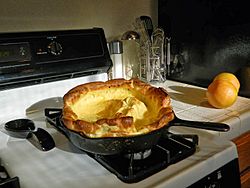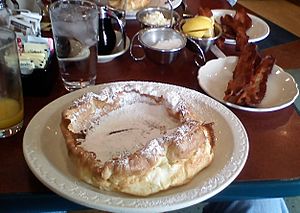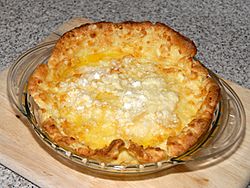Dutch baby pancake facts for kids

Dutch baby pancake fresh out of the oven
|
|
| Alternative names | German pancake, Bismarck, Dutch puff |
|---|---|
| Type | Popover |
| Place of origin | United States |
| Region or state | Washington |
| Main ingredients | Eggs, wheat flour, milk, vanilla, cinnamon |

A Dutch baby pancake is a special kind of large, fluffy pancake. It's also known by other fun names like German pancake, Bismarck, or Dutch puff. It's a type of popover.
A Dutch baby is similar to a big Yorkshire pudding. Unlike regular pancakes, you bake a Dutch baby in the oven. It's usually thicker than most pancakes. It also doesn't use baking powder to make it rise.
The idea for this pancake might come from a German pancake called Pfannkuchen. But the Dutch baby we know today was first made in the United States in the early 1900s.
Contents
Making a Dutch Baby Pancake
What You Need
To make a Dutch baby, you need eggs, flour, sugar, and milk. People often add vanilla and cinnamon for flavor. Sometimes, fruit or other flavors are added too.
A simple recipe uses about one-third of a cup of flour and one-third of a cup of milk for each egg.
How It's Baked
You bake a Dutch baby in a very hot cast iron or metal pan. It puffs up a lot in the oven. But it will fall (deflate) soon after you take it out.
It's usually served with fresh squeezed lemon juice, butter, and powdered sugar. You can also add fruit toppings or syrup.
When to Serve a Dutch Baby
Dutch baby pancakes can be served for breakfast, brunch, lunch, or even dessert. It's best to eat them right away after they come out of the oven.
Some restaurants that specialize in breakfast dishes serve Dutch babies. For example, The Original Pancake House in Oregon and Bickford's in New England offer them. Bickford's even has a "Baby Apple" version with apple slices baked inside.
The History of the Dutch Baby
According to Sunset magazine, Dutch babies first appeared in the early 1900s. They were introduced at Manca's Cafe in Seattle, Washington. This was a family-run restaurant owned by Victor Manca.
Even though these pancakes are based on German pancakes, Victor Manca's daughter supposedly gave them the name "Dutch baby." The word "Dutch" might have been her way of saying "German" (which is deutsch in German). Manca's Cafe even claimed to own the trademark for Dutch babies in 1942.
Pancakes That Are Similar
Popovers
A Dutch baby is a type of popover. However, popovers are usually baked as smaller, individual pieces. They are often about the size of a muffin.
Yorkshire Pudding
A Dutch baby is also very similar to a Yorkshire pudding. But there are a few differences:
- Yorkshire puddings are often baked in individual servings.
- The pan for Yorkshire puddings is usually greased with beef drippings, not butter.
- Yorkshire puddings are rarely sweet.
- Dutch babies are larger and use butter. They are also often sweet.
- Dutch babies use more eggs than a Yorkshire pudding. They also normally have sugar and vanilla.
- Unlike a Yorkshire pudding, Dutch babies are usually cooked in a cast iron frying pan.
David Eyre's Pancake
 |
|
| Type | Pancake |
|---|---|
| Main ingredients | Eggs, milk, flour, nutmeg |
A David Eyre's pancake is a special version of the Dutch baby pancake. It's named after an American writer and editor named David W. Eyre.
The recipe for this pancake was shared by The New York Times Food Editor Craig Claiborne in 1966. He wrote about it after trying it at David Eyre's home in Honolulu. Eyre's version was based on a Dutch baby recipe from Victor Hirtzler's 1919 Hotel St. Francis Cookbook.
This recipe is also in The Essential New York Times Cookbook. The author, Amanda Hesser, says it's one of her favorite recipes.
See also
 In Spanish: Dutch baby pancake para niños
In Spanish: Dutch baby pancake para niños

